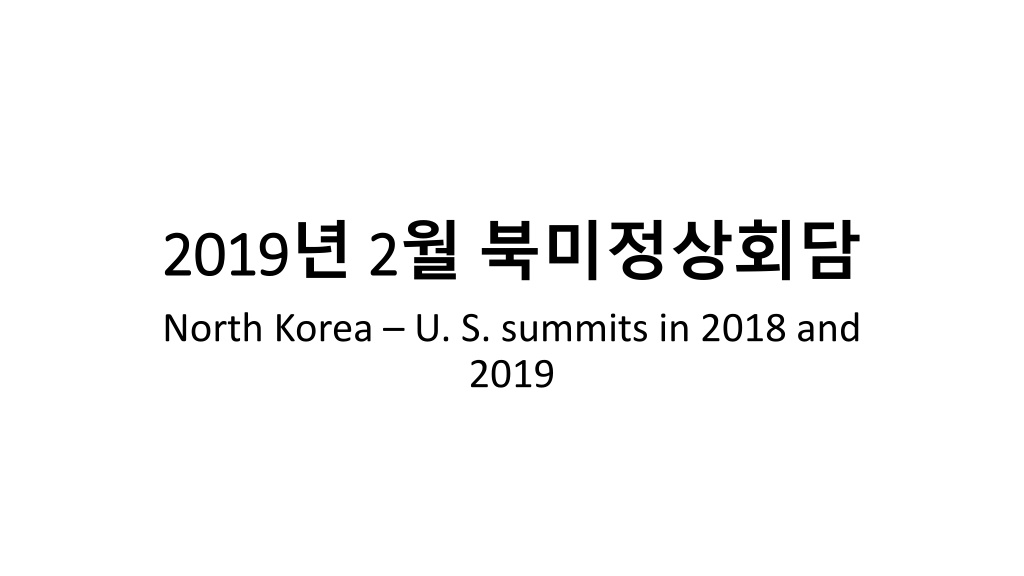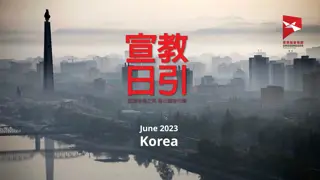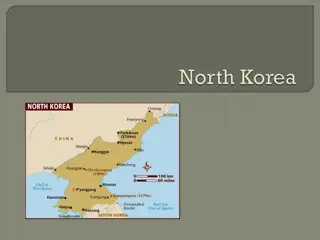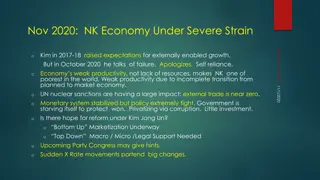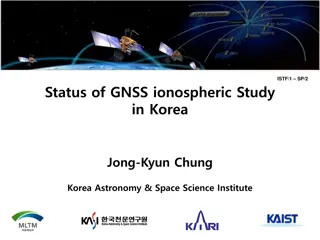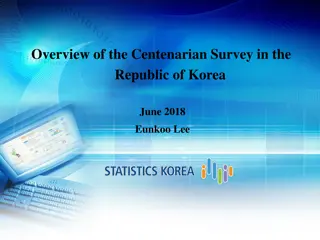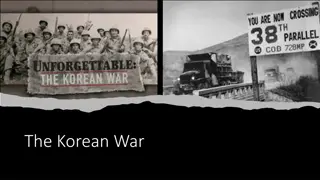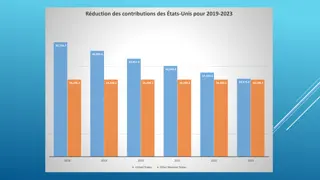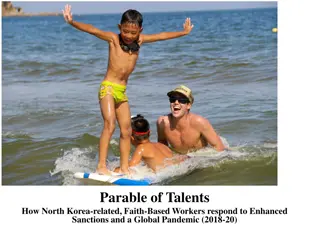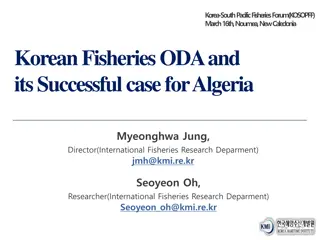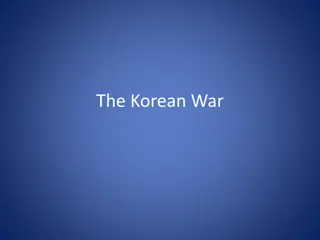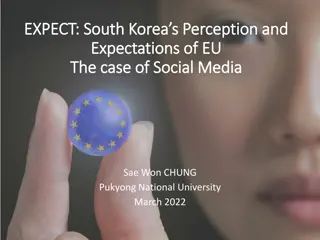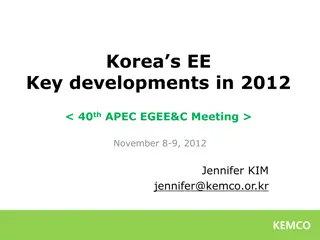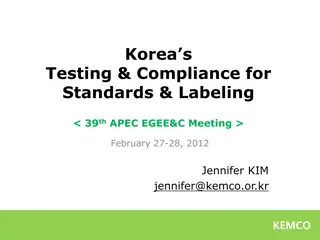The 2019 North Korea United States Hanoi Summit
The 2019 North Korea United States Hanoi Summit was a two-day meeting between North Korean chairman Kim Jong-un and U.S. president Donald Trump. The summit, held in Hanoi on February 27-28, 2019, ended abruptly with no agreement reached due to disagreements over sanctions. Preparations for the summit involved demands for lifting economic sanctions by North Korea and skepticism from American intelligence officials about North Korea's commitment to denuclearization. Trump's diplomacy with North Korea faced challenges, despite his claims of progress. Gaps persisted between the two countries on the definition of denuclearization.
Download Presentation

Please find below an Image/Link to download the presentation.
The content on the website is provided AS IS for your information and personal use only. It may not be sold, licensed, or shared on other websites without obtaining consent from the author. Download presentation by click this link. If you encounter any issues during the download, it is possible that the publisher has removed the file from their server.
E N D
Presentation Transcript
2019 2019 2 2 North Korea U. S. summits in 2018 and 2019
In brief The 2019 North Korea United States Hanoi Summit, commonly known as the Hanoi Summit, was a two-day summit meeting between North Korean chairman Kim J ng- n and U. S. president Donald Trump, held at the Metropole hotel in H N i, on February 27 28, 2019. This was the second meeting between the leaders of the DPRK and the United States, following their first meeting in Singapore the previous year. On February 28, 2019, the White House announced that the summit was cut short and that no agreement was reached. Trump later clarified that it was due to North Korea's request to end to all sanctions. North Korean foreign minister Ri Y ng-ho only sought a partial lifting of the five United Nations sanctions placed on North Korea between 2016 and 2017. In September 2018, The New York Times reported that "North Korea is making nuclear fuel and building weapons as actively as ever" but is doing so quietly, "allowing Mr. Trump to portray a denuclearization effort as on track." Two months later, The Times reported that North Korea appeared to be engaged in a "great deception" by offering to dismantle one missile base while developing sixteen others. The Times reported this expansion program was long known to American intelligence but contradicted Trump s public assertions that his diplomacy was yielding results. Immediately following the June 2018 summit, Trump had declared "There is no longer a Nuclear Threat from North Korea ... sleep well tonight!" A third inter-Korean summit was held on September 18 20 in 2018, seeking a breakthrough in the hampered talks with the U.S. and a solution for the denuclearization on the Korean Peninsula. asserted that the country
Preparations In November 2018, North Korea repeated its demand that U.S. economic sanctions be lifted as a condition for proceeding with talks, while the Trump administration continued to insist that North Korea make concessions first. Meetings between Secretary of State Mike Pompeo and North Korean officials were scheduled, canceled due to disagreements, and then rescheduled. The February 2019 summit was confirmed after Kim Y ng-ch l , North Korea s top negotiator met with Trump in the Oval Office on January 18, 2019. In the days leading up to the summit, Trump declared that former president Barack Obama had been on the verge of going to war with North Korea and had told Trump so during the transition, which suggested that Trump had pulled the U.S. back from the brink of war; however former Obama aides denied these claims. Trump also suggested that he deserved the Nobel Peace Prize for his diplomacy with North Korea, with the U.S. informally asking Japan to nominate Trump, according to Japanese newspaper Asahi Shimbun, which Japan s prime minister Abe Shinz did so according to it, but reports were neither confirmed nor denied, as it is tradition to keep nominations confidential. Top American intelligence officials testified to Congress in January 2019 that it was unlikely North Korea would fully dismantle its nuclear arsenal, and Trump national security advisor John Bolton continued to believe North Korea could not be trusted and that denuclearization efforts would fail. Trump asserted that North Korea s pause of weapons testing since the Singapore summit was a sign of progress, but experts said there had been longer testing pauses during previous administrations.
Prior to the Hanoi summit Going into the summit, wide gaps persisted between the two countries, including disputes on what the exact definition of denuclearization entailed. In January, Biegun had repeated the official American stance was that sanctions on North Korea would not be lifted until the country had fully denuclearized. On January 31, 2019, Biegun indicated that American negotiators may not demand that North Korea provide a full inventory of its nuclear and missile programs as a first step toward denuclearization, a demand that North Korea had been resisting. On January 8, 2019, Kim J ng- n met with Chinese leader Xi Jinping to consult with him on the possibility of the Kim Trump summit in Vietnam. Kim J ng- n departed from Pyongyang on February 23, according to images released by the KCNA news agency. The exact itinerary was kept secret. The 4,500 kilometres (2,800 mi) trip took about 60 hours. The train arrived in ng ng railway station of the Vietnamese border city of ng ng on Tuesday February 26, and Kim was scheduled to travel to Hanoi by vehicle. Some experts analyzed the reason for long train trip instead of swift air travel, Kim J ng- n opts to follow his grandfather Kim Il-sung's footsteps in 1958 to Vietnam through China by using the train for a long journey.
The Hanoi summit The first day. One-on-one meeting : At Hanoi s Metropole Hotel, Trump and Kim had a one-on-one meeting for 30 minutes on Wednesday evening. They started the summit at 6:30 pm local time (6:30am Eastern Standard Time) with a handshake and then participated in a one-on-one meeting, with interpreters only. President Trump assured North Korea a "tremendous future for your country" in his initial comments with Chairman Kim. Chairman Kim described the second summit as a "courageous political decision" by Trump and also added that there had been "a lot of thinking, effort, and patience" between now and previous June summit in Singapore. On the first night of the summit, the White House announced that Trump and Kim would sign a joint agreement the next afternoon. The second day. One-on-one meeting: During the one-on-one meeting in Hanoi, Kim was asked by a reporter if he would consider opening a US liaison office in Pyongyang. Kim initially hesitated to answer the question and asked Trump to excuse the press from the summit room, but Trump urged Kim to answer the question, to which he responded through an interpreter that the idea was welcomeable . Trump acknowledged the response as a positive one. After that, another reporter asked if Kim was willing to shut down his nuclear program, to which he responded, "If I m not willing to do that, I wouldn t be here right now." The planned working lunch between Trump and Kim was canceled, as well as the potential joint signing ceremony.
Aftermath of the Hanoi summit One month after the summit ended, Reuters reported that on the second day of the summit Trump passed Kim a note that bluntly called for North Korea to surrender all its nuclear weapons and fuel, in similar fashion to the Libya model , a proposal the North Koreans had repeatedly rejected. The scheduled ceremonial luncheon was then abruptly canceled and the summit ended. The White House on Thursday, February 28, 2019, announced that the summit was cut short and that no agreement was reached. This unexpected turn of events caused stocks on the South Korea stock exchange to fall. President Trump said in a press conference after the summit in Hanoi that the summit was cut short because North Korea wanted an end to economic sanctions. President Trump elaborated by saying "Basically, they wanted the sanctions lifted in their entirety and we couldn t do that," Trump said. "We had to walk away from that particular suggestion. We had to walk away from that."
Divergence of views A news conference from DPRK: hours later, in a rare move, North Korean officials called a news conference. North Korean foreign minister Ri Y ng-ho offered a different account of his country's position compared to Trump; that North Korea had proposed only a partial lifting of sanctions. 5 out of a total of key 11 United Nations sanctions, Ri stated that North Korea wanted 5 sanctions originally imposed in 2016 and 2017 lifted. In exchange, Ri said that North Korea offered to "permanently and completely" dismantle its primay nuclear facility in Yongbyon, and that American experts would be allowed to observe. Ri also quoted North Korea as proposing to put in writing that the country would end all nuclear tests and long-range missile tests. Ri continued that the North Koreans saw that no agreement could be made after the United States demanded one further measure in addition to destroying the Yongbyon nuclear facility. Lastly, Ri concluded that North Korea's proposal would not be changed. According to NK News, Vice Foreign Minister Choe S n-h i made the proposal to dismantle Yongbyon just before the talks collapsed, but the U.S. team walked out when Choe was unable to give details. NBC News reported on the second day of the summit that American negotiators had dropped their demand that North Korea provide a detailed inventory of its nuclear and missile programs. NBC also quoted U.S. official's speech: the current focus of deal is the Yongbyon nuclear reactor. Nuclear scientist Dr. Siegfried Hecker claimed: "Yongbyon is the heart of North Korea's nuclear program, and if we are completely dismantling the Yongbyon nuclear facility, North Korea would never be able to make plutonium there again".
Vietnam as an example for North Korea DPRK Supreme Leader Kim J ng- n political and economic history during the second Trump-Kim summit. While the country has strict rules against political liberalization, it is fairly lax in their social, religious, and economic guidelines. Citizens were able to travel to neighboring countries often. Vietnam also pursued multi-front foreign policies so they would not be dependent on just one economy and built modern systems for banking and finance. According to the BBC, the DPRK can also learn from Vietnam's mistakes in the past regarding managing their natural resources and handling political unrest. The BBC believes these are some cases the DPRK could learn from Vietnam's practice to help them in improving their economy by attracting foreign investors and developing closer relations with other countries. It is also assumed by the BBC that Vietnam's economic reform is a better pattern for the DPRK to follow than China's. China and the DPRK are of the corresponding inclination after Kims' four visits to China and the relationship between China and North Korea "indicates some kind of coordination". China believes that it is impossible for North Korea to abruptly destroy nuclear missiles. However, it is hoped that North Korea's nuclear missile program will be shut down gradually, as economic sanctions against North Korea will be eased. could potentially learn from Vietnam's social,
The nuclear story Experts believe that Supreme Leader Kim told United States Secretary of State Mike Pompeo "[that] he is a father and husband and he does not want his children to live their lives carrying nuclear weapons on their back". He also believes that the DPRK tried to strike a deal with previous administrations, but they waited too long, and they aim to finalize the deal with the Trump administration before it's too late. Kim assessed that the closure of the Yongbyon nuclear facility will be the beginning of full denuclearization and that this could lead to a peace treaty. The Yongbyon facility is known to be the center of nuclear development and research in North Korea. Though no concrete agreement regarding denuclearization was reached, DPRK President Kim was quoted last Tuesday (5 March) that he was committed to the complete denuclearization of his country. However, the description of denuclearization seems to be different between the U.S. and North Korea, which was why Stephen Biegun, Special Representative for North Korea, advised that the U.S. will not accept a phased denuclearization . Even though no agreement was signed in Hanoi, both countries are open to future talks, which shows that some agreement was made regarding few agendas, like the installation of a liaison office in Phyongyang, North Korea.
Comments after the Hanoi summit No-deal outcome of the Hanoi summit was because both parties asked for more than what each could give. However, a no-deal is better than a bad-deal, and suggests that the two leaders should aim for realistic goals in future summits. Asking for huge deals from each other would not yield favorable results for both sides, but working on smaller, workable agreements that would be meritorious for both countries was better than leaving the negotiation table empty-handed. The Chos n Ilbo, one of the leading South Korean newspapers, reported on May 30, 2019 that Kim Hyok-chol, the lead working-level negotiator for North Korea at the Hanoi summit, was executed in March 2019, along with four other diplomats. The paper also reported that Kim Y ng-ch l , a top aide to Kim J ng- n , was sentenced to hard labor. However, several photos were later released on June 3, 2019 showing Kim Y ng-ch l alive and attending a musical performance alongside Kim J ng- n and Ri Sol-ju.
Comments after the Hanoi summit A senior fellow at the Cato Institute, Doug Bandow, compared the DPPK and U.S. relations to that of Reagan and Gorbachev, where the agreement resulted in the end of the Cold War. Bandow contended that President Trump was demanding unrealistically for Kim J ng- n to dismantle all his nuclear facilities, whereas Kim was only agreeing to shut down the Yongbyon Nuclear facility in exchange for a partial lifting of a few UN sanctions against his country. Asking continuously for an all nukes for sanctions deal is deemed as malicious in its intent and illogical and that it would put a strain on the U.S.-North Korean relationship, which was volatile in the past, and could result in more problems for Washington and its allies in Asia, according to Bandow. Others believe the Hanoi summit is not a complete failure, despite some public opinion, and also compared the state of affairs to the Reagan-Gorbachev era. Like Trump, Reagan also had to deal with negative public opinion regarding his dealings with the USSR, but he was able to remove all of the Soviet Union s intermediate nuclear-armed missiles with an INF deal. Compared to the USSR, North Korea is also not a normalized country, but President Trump was able to engage with the top leader of North Korea directly, something his predecessors George W. Bush and Barack Obama were not able to do in their combined 16 year term.
Comments after the Hanoi summit U.S. Senior Expert on North Korea, Frank Aum, said that future goals of the Trump administration should be the founding of smaller deals that resulted from the Hanoi summit. Deals that include the declaration of the end of the Korean War, exchange of liaison offices in both Pyongyang and Washington, some sanctions relief, and verified dismantling of some of North Korea's nuclear facilities (Yongbyon, Punggye-ri, and Dongchan-ri) are attainable. Trump s "Big Deal" approach to North Korea would have been unrealistic, since it is not possible to achieve complete denuclearization in two years. He also said that some of the road-maps to establishing complete denuclearization might be the most hopeful solution. Reuters revealed the existence of a document handed to President Kim by President Trump that may have caused the collapse of the Hanoi summit. The document and its contents were first proposed by John Bolton in 2004 and according to Washington-based expert on North Korea, Jenny Town has been rejected more than once and "... to bring it up again ... would rather be insulting."
Comments after the Hanoi summit Without regular communication from both sides, it will be impossible to reach an agreement as they are both skeptical of one another s intent. Stephen Biegun did not meet with his North Korean counterpart before the summit at Hanoi took place, which resulted in the meeting not having enough support for negotiations. Meetings between both teams are needed to arrange the details that would result in bigger bargains without miscalculations and misunderstandings. In order for the two leaders to reach a deal, their teams need to work together. Joseph Yun, until March 2018 the American Special Representative for North Korea Policy, said of the summit's outcome, This really speaks to the lack of preparation. You cannot draft a joint statement out of nothing. They never quite got around to building a consensus around sanctions, and that led to the deadlock. Veteran diplomacy and national security journalist Michael Gordon reported in The Wall Street Journal: "If the two sides had opted for the traditional bottom-up approach to diplomacy, their diplomats would have worked to close the divide and only arranged for a summit when they appeared to be within striking distance of an agreement. However, U.S. and North Korean diplomats have had only intermittent meetings since the June summit, and both sides bet they would be more successful by pressing their case at another summit.
The DMZ meeting On June 12, 2019, Trump received a letter from Kim J ng- n which he described as "beautiful." On 30 June 2019, Kim J ng- n again met with U.S. President Donald Trump at the Korean Demilitarized Zone with Trump being the first sitting US president to set foot on North Korean soil, shaking hands warmly and expressing hope for peace. Kim and Trump then joined South Korea s President Mun Jae-in for a brief chat, marking an unprecedented three-way gathering. The two leaders agreed to restart negotiations for the Korean denuclearization process. The 2019 Koreas United States DMZ Summit was a one-day summit held at the Korean Demilitarized Zone between Kim J ng- n , Donald Trump and Mun Jae-in, following the 2019 G20 Osaka summit. Trump briefly stepped over the border at 3:45 PM (GMT+9) on June 30, marking the first time a sitting U.S. president had set foot on North Korean soil. It was also the second time since the end of the Korean War in 1953 that a North Korean leader entered the South's territory, following the April 2018 iner-Korean summit. A number of other sitting U.S. presidents had previously traveled to the DMZ and seen North Korea through binoculars, but none had previously met the leaders of North Korea or actually traveled within North Korean territory.
The DMZ meeting Following the conclusions of the 2019 G20 Osaka summit in Japan, on June 30, 2019, Trump and South Korean president Mun Jae-in visited the DMZ before the meeting with North Korean leader Kim J ng- n . Kim invited Trump to cross the border line, and Trump briefly crossed in North Korea before crossing back into South Korea together with Kim. Trump thus became the first U.S. president to enter North Korea. Before crossing into North Korea, Kim told Trump in Korean, "it's good to see you again" and "I never expected to meet you at this place", and shook hands with Trump. Trump said it was "my honor" to enter North Korea. During their meeting, Trump also invited Kim to the White House, although later acknowledged that this would probably not occur in the near term. Trump said of Kim: "A lot of really great things are happening, tremendous things. We met and we liked each other from Day One, and that was very important." Moon later joined Trump and Kim, and the three spoke for a brief moment before Kim and Trump held a 53-minute-long private meeting inside the Freedom House. Trump's top advisor Ivanka Trump, senior advisor Jared Kushner, Secretary of the Treasury Steven Mnuchin and United States ambassador to South Korea Harry B. Harris, Jr., accompanied Trump to the DMZ. Ivanka Trump joined the president in his meeting with Kim. Moon did not attend; the North Korean Foreign Ministry had announced a week before that he was not welcome, telling South Korean authorities to "mind their own business at home". In remarks after the meeting, Kim said, "By meeting here, which is a symbol of division, the symbol of a hostile past...we are presenting to the world that we have a new present, and this is announcing to the world that we will have positive meetings going forward."
The DMZ meeting Following the nuclear summit, both sides had announced the resumption of "working-level" nuclear talks. U.S. secretary of state Mike Pompeo said that Trump administration negotiators would meet North Korean counterparts to resume denuclearization talks in mid-July. U.S. special envoy to North Korea, Stephen Biegun, would lead the U.S. negotiators; the North Korean lead negotiator has not been appointed, although senior diplomat Choe S n-h i was viewed as a likely choice. Days after conclusion of the summit, commercial satellite imagery indicated that reconstruction of the Sohae ICBM launch site, which North Korea previously appeared to be dismantling, may have been underway even during the summit, and the site could be operational. A senior State Department official acknowledged some level of reassembly . In the lead-up to the meeting, Trump administration officials had been internally considering the prospect that a new round of U.S. North Korea negotiations could lead to the U.S. accepting "a nuclear freeze, one that essentially enshrines the status quo, and tacitly accepts the North as a nuclear power" rather than complete denuclearization. Under this possible outcome, North Korea would halt the growth of its nuclear arsenal, but would not dismantle any of the estimated 20 60 existing nuclear weapons already in its stockpile, and would not curb its ballistic missile capabilities. Biegun said that commentary about possible outcomes was speculative and said he was "not preparing any new proposal currently".
The DMZ meeting - comments Former Trump administration deputy national security advisor K. T. McFarland compared the Trump Kim DMZ meeting to the Nixon-Mao meeting in 1972, dismissed critics of the meeting, and said "If Kim doesn't deliver on this, I think he may have potential problems within his own leadership cadre." Opponents of Trump s policy commented that our president shouldn t be squandering American influence on photo ops and exchanging love letters with a ruthless dictator . There's a reason why past presidents chose not to go to North Korea while in office: such visits grant enormous legitimacy to the Kims. By meeting Kim at the DMZ without preconditions attached, Trump was signaling that North Korea was "a normalized, nuclear power. The DMZ meeting was "symbolism utterly devoid of substance" and Kim had taken advantage of a "gullible" Trump to improve his own legitimacy. The third Trump Kim meeting was viewed by some as a positive trust-building event that could be considered "necessary to get the working level talks back on track . China s foreign minister Wang Yi called the Kim Trump DMZ meeting a "rare opportunity for peace" and said that Chinese president Xi Jinping had urged the U.S. to "show flexibility" by easing its sanctions against North Korea in gradual "action-for-action" phases, rather than offering sanctions relief only upon complete nuclear disarmament. Cheong Seong-chang of the Sejong Institute, a South Korean think tank, said that in meetings between Kim and Xi in North Korea, "Xi pledged economic cooperation and a security guarantee to North Korea in exchange for Pyongyang's continued effort on denuclearization negotiations."
Aftermath of the DMZ meeting On October 5, U.S. and North Korean officials held working-level nuclear talks in Stockholm, but did not reach any agreement. The U.S. side proposed helping North Korea develop the Wonsan-Kalma coastal tourist area (near the Kalma Airport) After the Stockholm meeting, Pyongyang's chief nuclear negotiator Kim Myong Gil said further talks would depend on will of the U.S. Swedish Special Envoy Kent Harstedt expressed cautious optimism that the talks would continue. In November, North Korea s U. N. Mission announced that the country has gained no progress from U.S although two leaders committed to establishing a new relationship during the first US-DPRK summit. Vice Minister of DPRK Choe S n-h i said another US-North Korea summit would be feasible if U.S. remove hostile policy toward Pyonyang. North Korea has called for an end to joint military drills of USFK. Revitalization of the senior officials channel to DPRK On September 10, Trump sacked National Security Advisor John Bolton, saying he strongly disagreed with Bolton s suggestion about applying the Libyan model to the North Korea nuclear deal and mentioning Mu ammar Qa afi. Donald Trump selected hostage negotiator of DPRK Robert O Brien as the new U.S. national security adviser. North Korea envoy Biegun was confirmed as deputy secretary of state which is Pompeo's number two. While Pompeo was recognized as a protector of Trump, Biegun is unknown for his partisanship.
Aftermath of the DMZ meeting Request of working level talk to North Korea: on December 11, 2019, during U. N. Security Council meeting, U.S. envoy to the United Nations, Kelly Craft announced that the U.S. is ready "to simultaneously take concrete steps" with flexible approach, in other words for "balanced agreement" of the nuclear deal with DPRK. Craft also warned DPRK that its deeply counterproductive ballistic missile tests risk closing the door on prospects for negotiating peace. Craft emphasized that Security Council would be ready to act accordingly by Security Council action if North Korea resume serious provocations". Craft, who chaired the UN Security Council, requested DPRK back to the negotiation table for taking concrete, parallel steps toward an nuclear agreement.
